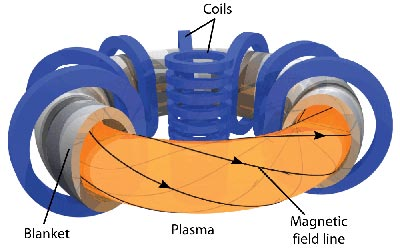Our story
Filippo Elio began his career in nuclear fusion research in 1984 for the design and the construction of a large RFP apparatus at “Istituto Gas Ionizzati”, a department of CNR in Padua (Italy).
In 1994 he was selected by EURATOM for the European part of the ITER project group and contributed to the Blanket, First Wall and Vessel, including construction and testing of pre-series prototypes. Being in the Garching headquarters at the “Max Planck Institute fuer Plasmaphysic” he got in contact with the German group that built the new advanced and super conducting Stellarator W7X, so between 2003 and 2005 he collaborates in the redesign of some critical parts of the magnet support structure. The Stellarator is developed in Europe as back up solution to the Tokamak, while the RFP has been omitted due to the poor experimental achievements.
In this way Filippo became experienced in the three major lines of fusion research: Tokamak, Stellarator and RFP. These lines were pursued by researchers all over the world in order to to achieve fusion by magnetic confinement of hydrogen and his work was appreciated by many key contributors in the research.
Faced with the prospect of not seeing any short term development in nuclear fusion, Filippo began to review once again plasma physics and check past experiments carried out all around the world in research laboratories. This is how in 2010 the idea of Polomac was born: a model of what happens in the Earth’s ionosphere, in continuation of the experimental and theoretical works performed from 1960 to 1990 in many research laboratories.
Given the remarkable simplicity and feasibility of the Polomac when compared to the Tokamak and the Stellarator, and faced with the urgent need for new clean energy, Filippo decided to leave the European Commission and to build the Polomac by setting up a private company.
The business
The aim is the industrial exploitation in the short term of the nuclear fusion of hydrogen into helium for the production of thermal and electrical energy, through the magnetic confinement with the Polomac scheme, which is different from the Tokamak and the Stellarator.
The Polomac, compared to the Tokamak, works in a stable and continuous way and it is simpler to build than the Stellarator. Reference is made to these two famous and established schemes because Polomac is based on the same physics, and experiences accumulated over decades of research around the world.


The Polomac is not an abrupt idea, it takes up the scheme of the poloidal magnetic field studied and experimented all over the world in the years 1960-70, then abandoned in favor of the Tokamak, but re-proposed in 2005 by the MIT in Boston with an incredible super-conductive magnet suspended in a vacuum by magnetic levitation. This recent and innovative application has highlighted the very high efficiency of the poloidal magnetic scheme, even if magnetic levitation introduces a complexity that has discouraged further developments towards industrial application.

Polomac, instead, aims at the industrial application by simple solutions like the tunnels through the magnetic field. The tunnels allow the passage of the supports and the electrical and hydraulic connections for the conductor held inside the plasma. Therefore, the Polomac is assembled with conventional flat magnets and works with a magnetic field 4-5 times less intense than that one needed for the Tokamak.

the vertical elongation produces a straight portion with uniform magnetic field
where the tunnels to support and feed the dipole are arranged.
More information on the basic physics of Polomac is included in the section TECHNOLOGY. The continuous operation and simplicity of construction make the Polomac suitable for industrial applications.
Magnetic tunnels
The magnetic tunnels across the outboard straight portion of the Polomac reach the dipole inside the vessel to support, feed and cool the coils.


the 4 side coils include a portion of dipole coil, a portion of outer coil and 2 radial branches.


The name
Deutelio comes from the Italian term ”DEUTerio” and “ELIO”. “Deuterio” stands for Deuterium (the isotope of hydrogen with atomic mass 2) and “Elio” for Helium, the inert gas produced by the reaction.

The Deuterium-Deuterium reaction evolves in two modes with equal probabilities up to the production of He4 (common natural isotope) with H and neutrons as ashes.
D2+D2=He3+n1+ 3.27 MeV after that He3+D2=He4+H1+18.3 MeV
D2+D2=T3+H1+4.03 MeV after that T3+D2=He4+n1+17.6 MeV
